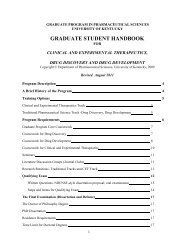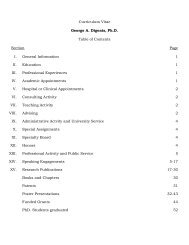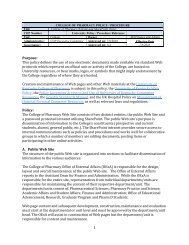Winter 2009 [pdf] - University of Kentucky - College of Pharmacy
Winter 2009 [pdf] - University of Kentucky - College of Pharmacy
Winter 2009 [pdf] - University of Kentucky - College of Pharmacy
Create successful ePaper yourself
Turn your PDF publications into a flip-book with our unique Google optimized e-Paper software.
Novel Anti-Overdose Drug Studied<br />
Devastating bodily<br />
harm caused by cocaine<br />
overdose may soon be<br />
avoided because <strong>of</strong> a<br />
new drug discovery<br />
made by <strong>University</strong> <strong>of</strong><br />
<strong>Kentucky</strong> <strong>College</strong> or<br />
Zhan<br />
<strong>Pharmacy</strong> researchers.<br />
By tweaking a naturally occurring<br />
enzyme, Chang-Guo Zhan, PhD, pr<strong>of</strong>essor<br />
in the Department <strong>of</strong> pharmaceutical<br />
sciences at UK’s <strong>College</strong> <strong>of</strong> <strong>Pharmacy</strong>,<br />
and his colleagues created a molecule<br />
that could flush a cocaine overdose<br />
out <strong>of</strong> the body before it can cause<br />
irreparable damage to the body.<br />
Currently, doctors can only try to<br />
relieve the symptoms <strong>of</strong> a cocaine<br />
overdose. If the enzyme undergoing<br />
research works in humans, it could<br />
remove the drug from a user’s body.<br />
Enzymes in the body combine cocaine<br />
with water and then, over a sequence <strong>of</strong><br />
reaction steps, break it down into two<br />
harmless products. However, this process<br />
is very slow – it takes up to 90 minutes<br />
to dispose half <strong>of</strong> even a tiny dose, and<br />
much longer for a large overdose. Zhan<br />
says that the molecule his team created<br />
can break down cocaine much faster.<br />
Courtney Swadley, a graduate student<br />
in the lab <strong>of</strong> Dr. Audra Stinchcomb, has<br />
been awarded a National Research Service<br />
Award Fellowship from the National<br />
Institute on Drug Abuse. Prior to joining<br />
the Pharmaceutical Sciences graduate<br />
program in 2005, Courtney received a BS<br />
degree in chemistry from the <strong>University</strong> <strong>of</strong><br />
Pittsburgh.<br />
Courtney’s project focuses on studying<br />
and optimizing the skin permeation <strong>of</strong><br />
cannabinoid 1 (CB1) receptor agonists and<br />
their analogs. CB1 receptor agonists show<br />
therapeutic potential in the treatment<br />
<strong>of</strong> numerous medical ailments including<br />
pain (e.g. chronic and neuropathic),<br />
nausea and vomiting, and substance<br />
abuse (e.g. alcoholism and smoking)<br />
“Our drug discovery was based<br />
on rational design using a novel<br />
computational approach,” said Zhan.<br />
Zhan and his colleagues, including<br />
scientists at the <strong>University</strong> <strong>of</strong> Michigan<br />
Medical School, calculated the energy<br />
required to perform each reaction step,<br />
which enabled them to determine how<br />
much energy a molecule should have<br />
to successfully react. Using computer<br />
simulations that systematically tweak<br />
the structure <strong>of</strong> the enzyme and predict<br />
the effect <strong>of</strong> these tweaks on the energy<br />
barrier, Zhan and his colleagues arrived<br />
at a candidate molecule that promised<br />
to speed up the degradation <strong>of</strong> cocaine<br />
by 2,000 times faster than the naturally<br />
occurring enzyme. The molecule<br />
was then synthesized and tested on<br />
animal models to determine whether<br />
it might work in the human body.<br />
Zhan says the overdose therapy should<br />
have few side effects in humans.<br />
“We expect that this candidate<br />
molecule can be tolerated very well in<br />
the human body because it is a variant<br />
<strong>of</strong> the primary cocaine-metabolizing<br />
enzyme in the human body and<br />
we have not made any change on<br />
the enzyme surface,” Zhan said.<br />
Swadley Receives NRSA Fellowship from NIDA<br />
making them very interesting for drug<br />
delivery research.<br />
These compounds are being investigated<br />
for transdermal delivery because <strong>of</strong> this<br />
delivery system’s advantages <strong>of</strong> providing<br />
a patient-controlled method <strong>of</strong> use,<br />
potential for controlled release and<br />
long term delivery application, and the<br />
ability to bypass first-pass and gastric<br />
metabolism. CB agonists are generally<br />
<strong>of</strong> large molecular weight and very<br />
lipophilic, making them good models for<br />
understanding the skin permeation <strong>of</strong><br />
compounds with similar physicochemical<br />
properties for which little information<br />
about skin permeation is available. This<br />
project is funded by grants from the NIH<br />
(F31) and the American Cancer Society.<br />
New Research Accounts<br />
July 1, 2008 to Dec. 15, 2008<br />
Dr. Bradley D. Anderson<br />
$60,001 from Boehringer Ingelheim<br />
for “Optimizing Oral Absorption <strong>of</strong><br />
Poorly Water Soluble Drug Candidates:<br />
Mechanisms and Predictive Models<br />
for the Selection <strong>of</strong> Excipients to<br />
Maintain Supersaturation by Inhibiting<br />
Nucleation and Crystallization.”<br />
Dr. Karen M. Blumenschein<br />
$5,000 from American Foundation<br />
for Pharmaceutical Education for<br />
“Do Patients and Pharmacists<br />
Agree on the Interpretation <strong>of</strong><br />
Verbal Probability Statements.”<br />
Dr. Peter A. Crooks<br />
$72,550 from <strong>University</strong> <strong>of</strong> Rochester<br />
for “A Novel Thiadiazolidine-Dione<br />
Targets Human Leukemia Stem Cells.”<br />
Dr. Charles D. L<strong>of</strong>tin<br />
$20,000 from PhRMA Foundation for<br />
“Fellowship for Julie Oestreich: The Effects<br />
<strong>of</strong> P2Y12 Polymorphisms on Platelet<br />
Receptor Expression and Activation.”<br />
Dr. Audra L. Stinchcomb<br />
$7,325 from AllTranz for “Evaluation<br />
<strong>of</strong> a Drug for Dermal Delivery.”<br />
Dr. Audra L. Stinchcomb<br />
$30,524 from National Institute on<br />
Drug Abuse for “NRSA Fellowship<br />
for Swadley: Transdermal Delivery <strong>of</strong><br />
Hydroxyphenylarachidonylamides.”<br />
Dr. Jurgen Rohr<br />
$251,484 from National Cancer<br />
Institute for “Novel Aureolic Acid-<br />
Type Antitumor Agents.”<br />
Dr. Jeffery C. Talbert<br />
$905,686 from Department for Mental<br />
Health Mental Retardation Service<br />
for “Research Information Systems<br />
Management for KY Department for<br />
Mental Health/Mental Retardation.”<br />
Dr. Jeffery C. Talbert<br />
$1,722,468 from KY Cabinet for<br />
Health and Family Services for<br />
“Money Follows the Person (MFP).”<br />
Dr. Steven Van Lanen<br />
$10,000 from Daiichi Pharmaceutical Corp.<br />
for “Biosynthesis <strong>of</strong> Nucleoside Antibiotics.”<br />
Dr. Chang-Guo Zhan<br />
$498,945 from National Institute<br />
on Drug Abuse for “High-Activity<br />
Mutants <strong>of</strong> Cocaine Esterase for<br />
Treatment <strong>of</strong> Drug Addiction.”<br />
<strong>Pharmacy</strong> Totals: $3,583,983<br />
16 Focus on <strong>Pharmacy</strong>


![Winter 2009 [pdf] - University of Kentucky - College of Pharmacy](https://img.yumpu.com/27653072/16/500x640/winter-2009-pdf-university-of-kentucky-college-of-pharmacy.jpg)
![Summer 2007 [pdf] - University of Kentucky - College of Pharmacy](https://img.yumpu.com/27653109/1/190x245/summer-2007-pdf-university-of-kentucky-college-of-pharmacy.jpg?quality=85)

![Summer 2007 [pdf] - University of Kentucky - College of Pharmacy](https://img.yumpu.com/27653114/1/167x260/summer-2007-pdf-university-of-kentucky-college-of-pharmacy.jpg?quality=85)
![Winter 2011 [pdf] - University of Kentucky - College of Pharmacy](https://img.yumpu.com/27653110/1/190x245/winter-2011-pdf-university-of-kentucky-college-of-pharmacy.jpg?quality=85)
![Summer 2011 [pdf] - University of Kentucky - College of Pharmacy](https://img.yumpu.com/27653115/1/190x245/summer-2011-pdf-university-of-kentucky-college-of-pharmacy.jpg?quality=85)

![PS Application Form [pdf] - University of Kentucky - College of ...](https://img.yumpu.com/27653102/1/190x245/ps-application-form-pdf-university-of-kentucky-college-of-.jpg?quality=85)
![Curriculum Vitae [pdf] - University of Kentucky - College of Pharmacy](https://img.yumpu.com/27653090/1/190x245/curriculum-vitae-pdf-university-of-kentucky-college-of-pharmacy.jpg?quality=85)
![Winter 2007 [pdf] - University of Kentucky - College of Pharmacy](https://img.yumpu.com/27653085/1/167x260/winter-2007-pdf-university-of-kentucky-college-of-pharmacy.jpg?quality=85)




![Summer 2008 [pdf] - University of Kentucky - College of Pharmacy](https://img.yumpu.com/24193256/1/190x245/summer-2008-pdf-university-of-kentucky-college-of-pharmacy.jpg?quality=85)